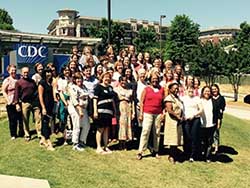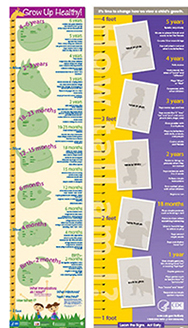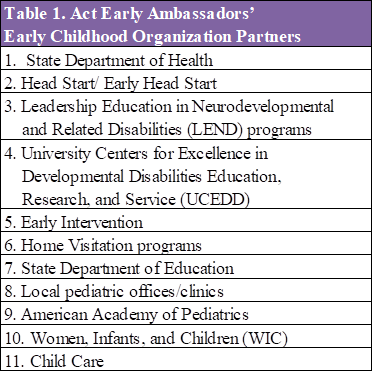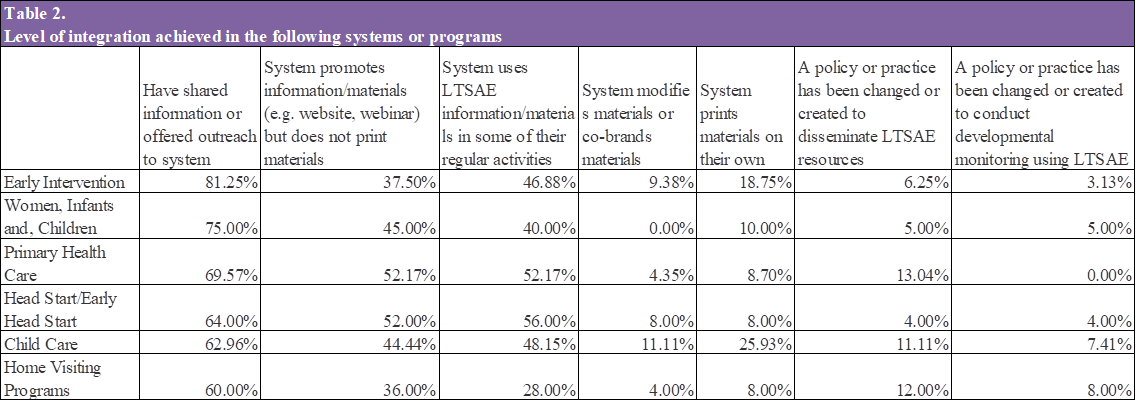"Learn the Signs. Act Early." Project Updates
January 9, 2018

|
The Act Early Ambassadors project is designed to develop a network of state-level experts who promote developmental monitoring and screening and improve early identification of DD/ASD practices. It is a collaborative effort on behalf of CDC's National Center on Birth Defects and Developmental Disabilities (NCBDDD), the Health Resources and Services Administration's (HRSA) Maternal and Child Health Bureau (MCHB), the Association of University Centers on Disabilities (AUCD), and the Association of Maternal and Child Health Programs (AMCHP). Act Early Ambassadors serve as state or territorial liaisons to the Act Early Initiative and act as a community champion or change agent to increase parent-engaged developmental monitoring of young children through the use of "Learn the Signs. Act Early." materials in early childhood systems and organizations.
Since 2011, professionals with medical, child development, developmental disability, special education, and early intervention expertise have been selected to
- Serve as a state or territorial point-of-contact for the national "Learn the Signs. Act Early." program;
- Support the work of Act Early State Teams and other state/territorial or national initiatives to improve early identification of developmental delay and disability; and
- Promote the adoption and integration of "Learn the Signs. Act Early." resources into systems that serve young children and their families.
New CDC Milestone Tracker App
![]() CDC's "Learn the Signs. Act Early." program is pleased to announce the release of the Milestone Tracker app for iOS and Android. This new app helps parents, early care and education providers, and healthcare providers track developmental milestones in young children. The app's many features include interactive milestone checklists for ages 2 months through 5 years, photos and videos to help parents recognize milestones, and tips and activities for supporting early development. Parents can use the app to easily share developmental progress with their child's healthcare provider and others and receive appointment and developmental screening reminders.
CDC's "Learn the Signs. Act Early." program is pleased to announce the release of the Milestone Tracker app for iOS and Android. This new app helps parents, early care and education providers, and healthcare providers track developmental milestones in young children. The app's many features include interactive milestone checklists for ages 2 months through 5 years, photos and videos to help parents recognize milestones, and tips and activities for supporting early development. Parents can use the app to easily share developmental progress with their child's healthcare provider and others and receive appointment and developmental screening reminders.
To download the app, visit the App Store or Google Play and search "CDC's Milestone Tracker." Visit www.cdc.gov/MilestoneTracker to learn more about the app and print a free promotional flyer or poster.
CDC's Director, Dr. Brenda Fitzgerald has lent her support in promotional activities around the app's launch including recording two videos providing an overview of Milestone Tracker and discussing how it can be used to benefit children, families and providers. These videos are available on YouTube (click hyperlinks below):
- CDC's Milestone Tracker App: For Parents
- CDC's Milestone Tracker App: What Healthcare Providers Should Know
Learn the Signs. Act Early. Grow Up Healthy! Growth Chart
 CDC's "Learn the Signs. Act Early." program is happy to offer a new resource to professionals and parents: the Grow Up Healthy! growth chart features recommended immunizations by age, important developmental milestones birth through age 6 years, and measures a child's height up to 56 inches. This family-friendly wall chart is available in English and Spanish and includes additional information on typical growth and development on the backside. The content was created in collaboration with CDC's National Center for Immunization and Respiratory Diseases, the American Academy of Pediatrics and the American Academy of Family Physicians. Grow Up Healthy! growth charts are available for download on the LTSAE Free Resource webpage or to order for free, in limited quantities, at www.cdc.gov/ActEarly/Orders.
CDC's "Learn the Signs. Act Early." program is happy to offer a new resource to professionals and parents: the Grow Up Healthy! growth chart features recommended immunizations by age, important developmental milestones birth through age 6 years, and measures a child's height up to 56 inches. This family-friendly wall chart is available in English and Spanish and includes additional information on typical growth and development on the backside. The content was created in collaboration with CDC's National Center for Immunization and Respiratory Diseases, the American Academy of Pediatrics and the American Academy of Family Physicians. Grow Up Healthy! growth charts are available for download on the LTSAE Free Resource webpage or to order for free, in limited quantities, at www.cdc.gov/ActEarly/Orders.
Additionally, "Learn the Signs. Act Early." has updated the Healthcare Provider webpage that assists providers with engaging families in developmental monitoring. This page provides tips on ways to integrate materials across healthcare settings and features the new promotional video Learn the Signs. Act Early. One Doctor's Story.
Expansion Into 11 New States/Territories
The Act Early Ambassador program is expanding into eleven new states in territories for 2018-2019!
Applications are due January 18, 2018 for up to 11 Act Early Ambassadors representing the following states and territories: Alaska, American Samoa, Arkansas, Delaware, Kentucky, Louisiana, Maryland, Northern Mariana Islands, North Dakota, Pennsylvania, Puerto Rico, Rhode Island, South Dakota, Wyoming will be funded; no more than 1 per state or territory listed. Ambassadors serve to improve early identification of developmental delays and disabilities, including autism, by:
- serving as a state or territorial point-of-contact for the national LTSAE program;
- supporting the work of Act Early State Teams and other state/territorial or national initiatives to improve early identification of developmental delay and disability;
- promoting the adoption and integration of LTSAE resources, including materials to support developmental monitoring (Milestone Tracker app, milestone checklists, Milestone Moments booklet, LTSAE children's books, Milestones in Action image library, etc.) and professional education tools ("Watch Me! Celebrating Milestones and Sharing Concerns" online training for early care and education providers) into systems that serve young children and their families or train those who serve young children and their families.
Please contact Danielle Webber, Act Early Program Manager, for more information.
Act Early Ambassador Program Successes  Table 1 displays early childhood organization partners with whom the 2014-2016 Ambassador cohort most often collaborated in rank order by number of collaborations. Table 2 displays the level of "Learn the Signs. Act Early." materials, messaging, and training resources integration that the 2016-2018 Ambassador cohort achieved in early childhood systems. The data in Table 2 show results from the May 2017 Ambassador report question, "Indicate the level of integration you have achieved in each of the following systems or programs.". These findings reveal results from the higher frequency collaborations Ambassadors' engaged in with the early childhood systems in Table 1. Eighty-one percent of Ambassadors have shared "Learn the Signs. Act Early." program information or offered outreach to Early Intervention. Fifty-two percent of the Ambassadors are successful in getting Primary Health Care system staff to promote LTSAE materials. Fifty-six percent of Ambassadors and their activities show efficacy in influencing Head Start/Early Head Start to use LTSAE materials in their regular activities. Eight percent of Ambassadors and their workplan activities have urged Home Visiting Programs to change or create a policy or practice to conduct developmental monitoring using LTSAE materials.
Table 1 displays early childhood organization partners with whom the 2014-2016 Ambassador cohort most often collaborated in rank order by number of collaborations. Table 2 displays the level of "Learn the Signs. Act Early." materials, messaging, and training resources integration that the 2016-2018 Ambassador cohort achieved in early childhood systems. The data in Table 2 show results from the May 2017 Ambassador report question, "Indicate the level of integration you have achieved in each of the following systems or programs.". These findings reveal results from the higher frequency collaborations Ambassadors' engaged in with the early childhood systems in Table 1. Eighty-one percent of Ambassadors have shared "Learn the Signs. Act Early." program information or offered outreach to Early Intervention. Fifty-two percent of the Ambassadors are successful in getting Primary Health Care system staff to promote LTSAE materials. Fifty-six percent of Ambassadors and their activities show efficacy in influencing Head Start/Early Head Start to use LTSAE materials in their regular activities. Eight percent of Ambassadors and their workplan activities have urged Home Visiting Programs to change or create a policy or practice to conduct developmental monitoring using LTSAE materials.

These data show the short-term outcomes including improvements in awareness and skills to medium-term outcomes including changes in practice, behavior, and policies that the Act Early Ambassadors planned and assisted in implementing for systems change to improve and increase developmental monitoring.







